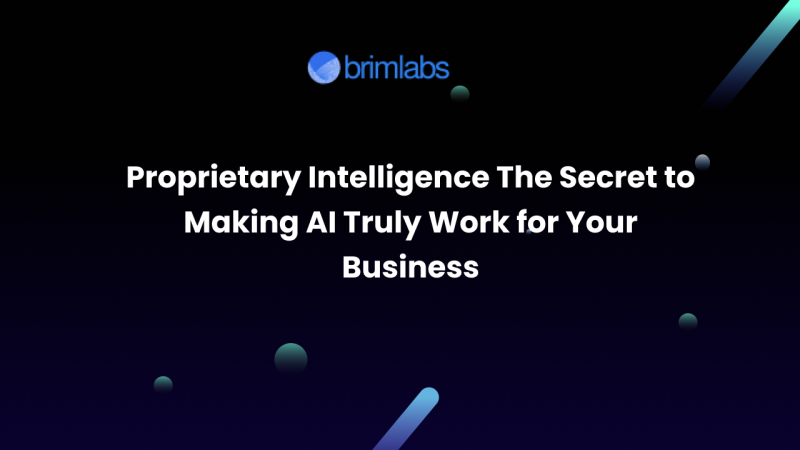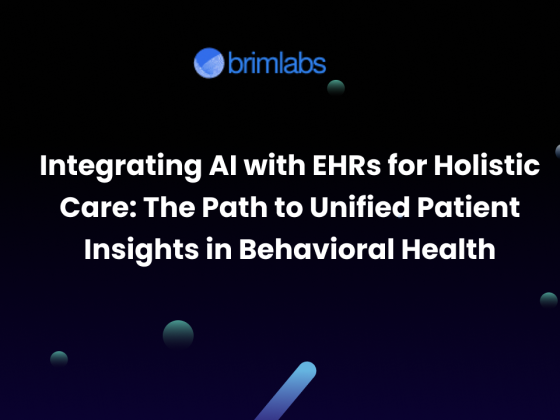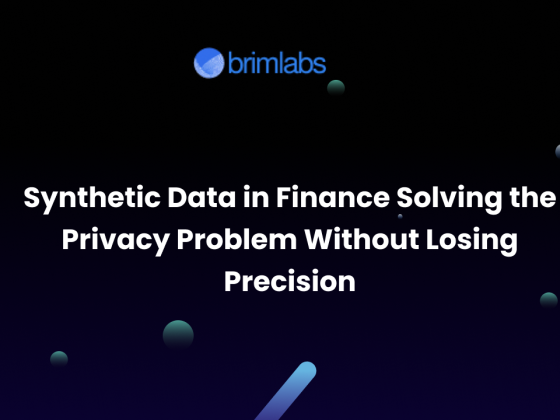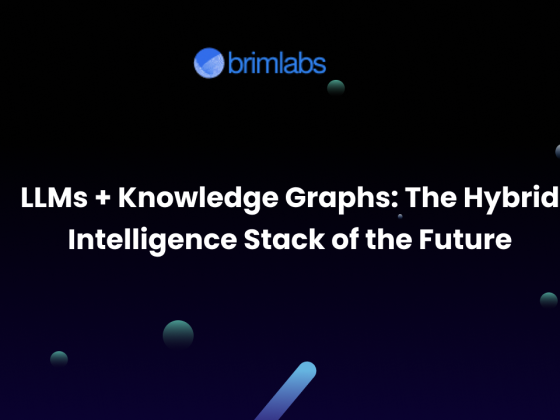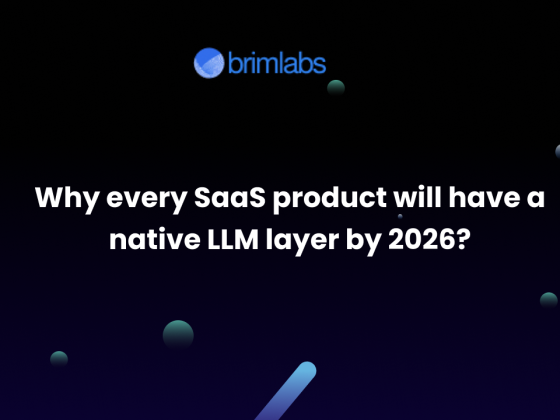In a world where artificial intelligence is now table stakes, not a differentiator, the real advantage no longer comes from having AI, it comes from owning your own intelligence. Proprietary intelligence is what separates companies that simply use AI from those that become AI-native. It’s the difference between adopting automation and creating an evolving system of insight that no competitor can copy.
Let’s unpack what proprietary intelligence truly means, why it’s fast becoming the ultimate business moat, and how it redefines growth and innovation in the age of generative AI.
Understanding Proprietary Intelligence
Proprietary intelligence refers to the unique knowledge layer that a business builds by combining its data, workflows, customer interactions, and decision logic into a self-learning system. Unlike generic AI models trained on public datasets, proprietary intelligence learns from your organization’s real-world operations and continuously adapts to your context.
It’s not about owning a large language model. It’s about owning the feedback loops that make that model smarter within your domain. For instance, two companies can use the same foundation model like GPT-4, but one that continuously feeds its proprietary datasets – customer feedback, support tickets, operational data, sales performance, and user behavior, will create an entirely different layer of intelligence. This layer becomes the company’s private brain: tuned, contextual, and irreplaceable.
Why Off-the-Shelf AI Isn’t Enough
Most businesses begin their AI journey with plug-and-play tools: chatbots, analytics dashboards, or pre-trained APIs. These off-the-shelf systems provide convenience and fast results but come with critical limitations.
1. Lack of Contextual Understanding: Generic AI models don’t understand your company’s tone, customer persona, or internal processes. They operate on general knowledge and often make decisions detached from your business reality. The result is surface-level automation, not deep insight.
2. No Competitive Moat: If you and your competitors use the same off-the-shelf model, the playing field is level, and not in your favor. The real competitive advantage lies in how you train and adapt that AI to your proprietary data. Without this layer, you’re effectively renting intelligence that anyone else can rent too.
3. Data Leakage and Compliance Risks: Relying on external APIs without proper isolation can expose sensitive information or violate compliance norms like GDPR or HIPAA. Proprietary intelligence systems are built on secure, private infrastructure, ensuring full control over data lineage, access, and retention.
4. Limited Integration and Scalability: Prepackaged AI tools are designed for broad use cases. They rarely integrate seamlessly with your internal systems or workflows. Proprietary intelligence, in contrast, evolves organically with your stack and adapts as your business scales.
The Core Building Blocks of Proprietary Intelligence
Creating proprietary intelligence isn’t a single project, it’s a strategic evolution. It’s built on five foundational components that work together to create a self-learning ecosystem.
1. Domain-Specific Data: Your organization already holds a goldmine of untapped information – CRM logs, support chat transcripts, call summaries, operational metrics, and behavioral analytics. Structuring and feeding this into your AI layer builds the foundation for proprietary insight.
2. Custom Knowledge Graphs: A knowledge graph represents relationships between your business entities, customers, products, policies, documents, and workflows. It helps the AI understand how your organization actually functions, bridging the gap between raw data and real-world meaning.
3. Feedback Loops: Intelligence compounds only when it learns from its own outputs. Integrating user feedback, operational performance, and quality checks ensures the AI doesn’t just respond, it improves continuously. These feedback loops are the heart of proprietary learning.
4. Private Infrastructure: Owning the infrastructure, whether on your own cloud or through virtual private instances, gives you full control over your data pipelines and models. This ensures compliance, traceability, and security while preventing data dilution through shared systems.
5. Custom Models and Prompts: While base models can be rented, your proprietary models and prompt libraries are unique. They capture your company’s language, workflows, and reasoning patterns. This is where generic AI becomes your AI.
Turning Proprietary Data into Strategic Advantage
To understand the power of proprietary intelligence, imagine two healthcare startups building AI assistants for patient care.
Both use the same LLM base, but one fine-tunes it on public medical data while the other feeds it years of anonymized clinical notes, patient feedback, and care outcomes. Over time, the second startup’s model starts identifying early symptoms faster, suggesting care plans that align with patient behavior, and offering insights that improve both care quality and efficiency.
That’s the compounding power of proprietary intelligence, it learns from your data, accelerates your decisions, and becomes your silent differentiator.
Proprietary Intelligence Across Industries
Let’s look at how proprietary intelligence is reshaping major industries.
Finance: Banks and fintechs are using proprietary intelligence to build adaptive credit scoring, fraud detection, and personalized advisory systems. Instead of relying on general AI risk models, they combine internal transaction histories, customer sentiment, and market dynamics to predict risk and design products with precision.
Healthcare: Hospitals and healthtech firms are turning unstructured EHR data, diagnostic histories, and clinical outcomes into adaptive intelligence systems. This enables predictive diagnostics, automated charting, and even patient-specific treatment recommendations, all while maintaining HIPAA compliance.
E-commerce: Retailers are blending behavioral analytics, search data, and conversion history to create hyper-personalized experiences. Proprietary intelligence allows their platforms to predict intent, reduce cart abandonment, and optimize pricing dynamically.
SaaS: SaaS companies are embedding proprietary intelligence into their products to make them adaptive. This could mean workflow assistants that learn how each user works, CRMs that auto-prioritize leads based on deal patterns, or analytics dashboards that proactively surface insights instead of waiting for queries.
Building Proprietary Intelligence in Practice
Developing proprietary intelligence involves deliberate steps across technology, culture, and process.
- Audit Your Data Sources: Map your structured and unstructured data. Identify where valuable signals reside, support logs, chat transcripts, user behavior, or product telemetry.
- Centralize Data and Build Retrieval Layers: Store clean, labeled data in a unified data warehouse or vector database. Build retrieval systems (like RAG pipelines) to make it easily accessible to your AI agents.
- Train and Fine-Tune Models: Use domain-specific datasets to fine-tune models. This ensures contextual precision and reduces hallucinations common in general-purpose AI.
- Integrate Continuous Learning: Set up human-in-the-loop validation. Let users flag incorrect outputs and feed that back into your models to refine future responses.
- Establish Governance and Ethics Frameworks: Ensure transparency, bias detection, and regulatory compliance. Proprietary intelligence must be trustworthy before it can be transformative.
- Measure Intelligence ROI: Track how intelligence improves KPIs, conversion rates, ticket resolution times, churn, or user satisfaction. These metrics prove that intelligence is not just automation but a growth engine.
The Strategic Value of Proprietary Intelligence
Businesses that invest in proprietary intelligence don’t just build smarter systems, they build defensible value. It becomes the cornerstone of their brand, efficiency, and decision-making.
- Moat Creation: Competitors can copy your features but not your intelligence. Your insights, workflows, and behavioral learnings are inherently unique.
- Efficiency and Predictability: Continuous learning reduces errors, speeds up decisions, and anticipates operational bottlenecks.
- Customer Trust: Personalized and accurate interactions improve user satisfaction while reducing privacy concerns tied to third-party systems.
- Future Readiness: As regulations evolve and AI becomes regulated, companies with internal intelligence frameworks will already meet compliance and audit requirements.
The Shift from AI Adoption to Intelligence Ownership
We are witnessing a fundamental shift in how businesses perceive AI. The first wave was about adoption, getting something to work. The next wave is about ownership, making it yours. Proprietary intelligence transforms AI from a utility into an asset, a learning organism that compounds value over time.
It’s not about being first to use AI, but about being the last one standing with the intelligence that no one else can replicate.
Conclusion
Proprietary intelligence is the ultimate expression of digital maturity. It’s what turns data into decisions, workflows into wisdom, and automation into foresight. Every business that aspires to survive the next AI decade must evolve from using AI to owning intelligence.
At Brim Labs, we help organizations build this foundation, from data pipelines to custom AI models that reflect your domain expertise and amplify your strategic advantage. Whether it’s in fintech, healthcare, SaaS, or e-commerce, our AI-native engineering teams help you move from off-the-shelf automation to true proprietary intelligence, one that learns, adapts, and grows with your business.

